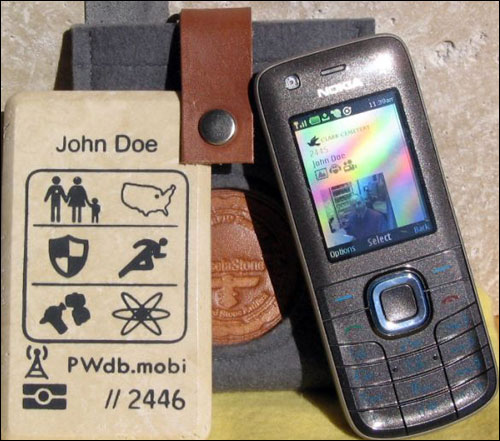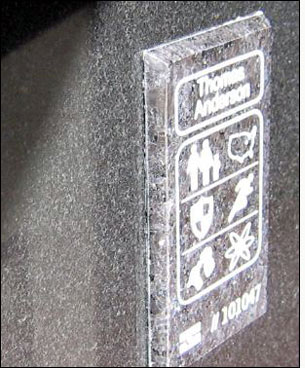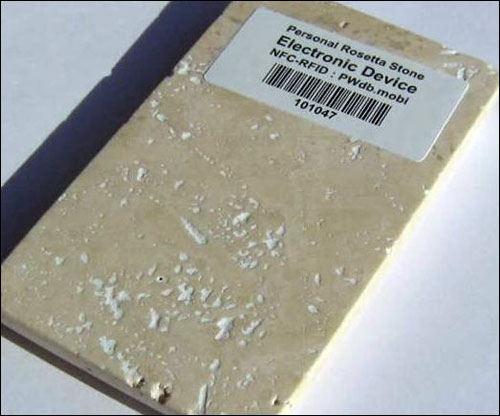Gravestones often display limited information—typically, just the name of the deceased, along with that person’s date of birth and death, and sometimes a terse epitaph. In the case of a new growing trend of green burials, in which graves have no stone at all, memorializing a deceased loved one becomes even more difficult. Objecs LLC, an Arizona information-exchange company specializing in the sharing of digital information between individuals and objects, is offering alternative way to memorialize a loved one: the RosettaStone—a stone tablet with a passive high-frequency (HF) 13.56 MHz RFID tag embedded inside.
The tag complies with the ISO 14443 RFID and Near Field Communication (NFC) standards, and its ID number is linked to a database that stores details about a person, so that anyone with an NFC-enabled phone or handheld device can access more data (up to 1,000 words) and a photo of the individual who has died. For the sake of redundancy, text (such as a URL) indicating where that information can be accessed is also stored on the tag.

Objecs provides data-exchange technology for the industrial market, for such applications as storing details regarding a piece of equipment. By means of RFID, 2-D bar codes or a printed serial number, users can link equipment or other objects to data about those items on a Web-based server, hosted by Objecs. That information may include new technical service bulletins, or basic how-to fix it details.
In 2009, the company received a request to use its Web application to support data linked to ID numbers printed on round polymer tags, attached to grave markers at a cemetery in Portugal. The cemetery contained historic graves of interest, such as important military officers, some as much as 600 years old. The agency wanted to preserve the information related to those buried in the graveyard, and to make it accessible to visitors. Since then, Objecs has begun marketing the solution for the American memorial market, with an added technological tool—an NFC RFID tag.
The company offers two tablets: the Personal RosettaStone (made of travertine) and the Memorial RosettaStone (composed of granite). Because it is made of a less durable and more decorative stone, the travertine tablet is intended for those who would hold onto the tablet as a keepsake. Both versions measure 2.4 inches in width by 4 inches in length.
Up to 1,000 words of information regarding the deceased individual—such has his or her family, interests, career and so forth—is input into the Web-based server at the time of purchase, and the tablet is then sent to the user with an ID number printed on the front, as well as encoded onto an NFC tag embedded in the stone. Users can simply go to the RosettaStone Web site and enter the number engraved on the tablet in order to access data and a picture of the departed. For those with an NFC-enabled mobile phone, however, the information can be accessed immediately on the phone, without having to input numbers. When the NFC phone is tapped near the tablet, it captures the unique ID number and links it to the data on the server, which is then presented on the phone’s screen. The information is stored both on the RosettaStone server, and on the Physical World Database Project server, also hosted by Objecs.
“We treat our files like genealogical records,” says John Bottorff, Objecs’ owner. “If our company goes away, the records are still preserved.” The data is stored on the RosettaStone and PWDB sites, and the firm plans to provide the data “on another trusted Internet archive environment,” Bottorff says, though he adds that he cannot yet name which server this will be. This data, he says, could be shared with another requested server, such as a mortuary’s site.
The granite tablet, which is thinner than the travertine version—approximately 0.3 inch in thickness, versus 0.4 inch—is more likely to be attached to a headstone itself. Installation is typically performed by the headstone manufacturer, by cutting a 1/4-inch recess into the stone and inserting the tablet into that space. Alternatively, the tablet also comes with an adhesive strip that the consumer could then use to apply it directly to a headstone’s surface. Because the tablet is made of granite, it has a long lifetime, estimated at 3,200 years.
For those seeking a green burial or cremation, Bottorff says, the travertine tablet has been gaining interest, because it offers a method for memorializing an individual who does not have a grave marker. The tablet would be taken home as a family keepsake.
To date, the company has sold fewer than 100 of the tablets since they were introduced this year, but with as NFC technology is included in more American phones in the future, Bottorff expects that the NFC chip will become an important product feature. Interest has been growing, he indicates, and customers now have a limited wait for their personal tablet. Many orders, he says, are made directly through the company’s RosettaStone Web site, and are being placed for the living, such as those ordering their own tablet to leave for their children, with no intention of installing the tablet on a headstone, but simply providing it for the family to keep as a remembrance.
The travertine tablet costs $205, while the granite is priced at $225.



